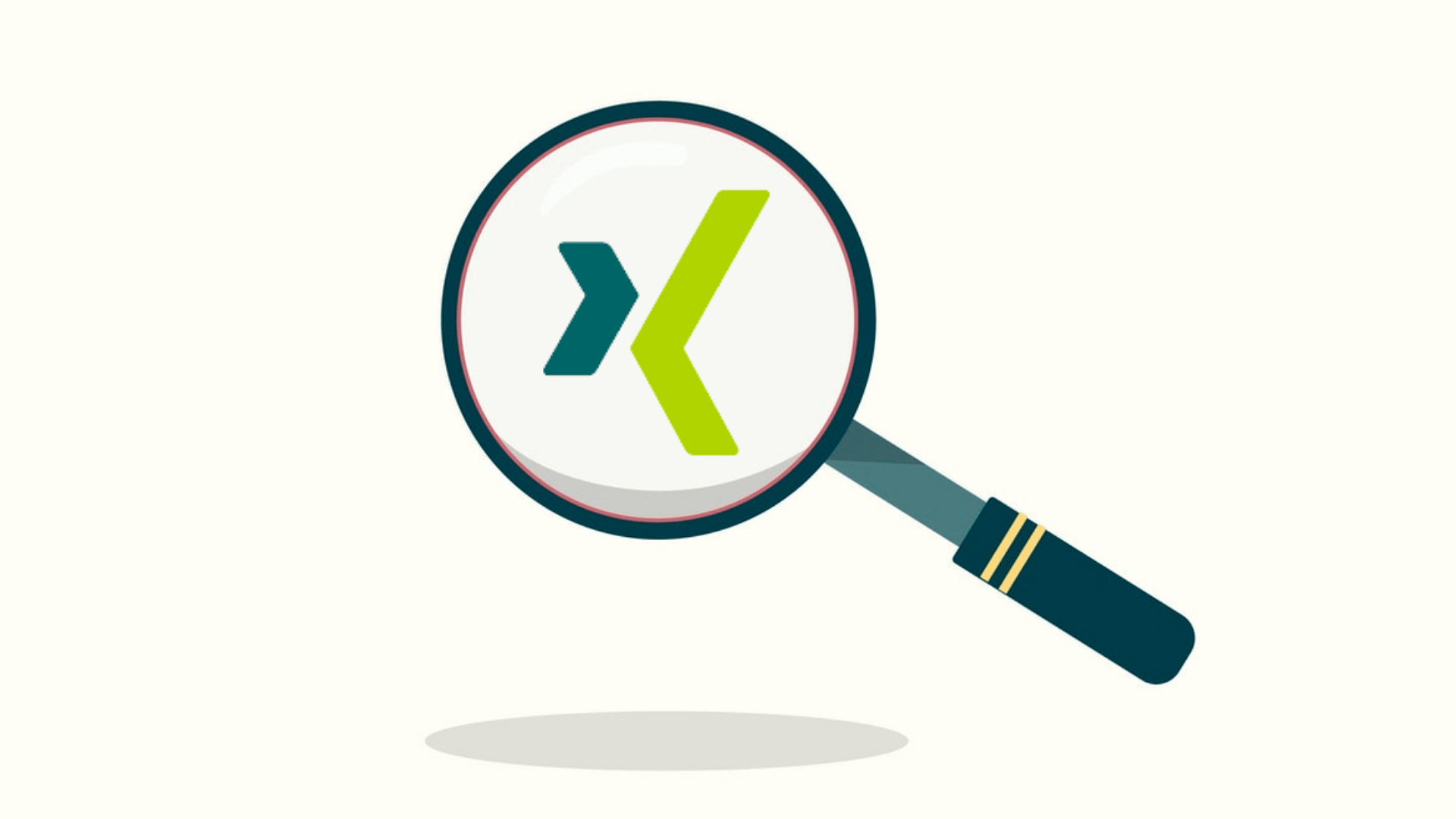Xing: the nuts and bolts
Written by
Kinga EdwardsPublished on

Probably, you have heard about this platform a few times, especially if you operate in the German market. What is the drill about it? How does it work and why should you know Xing? Keep reading.
In this text, you will find the most important information, statistics, and facts about Xing. Grab a pen and make some notes. But a little warning, after reading this you may probably want to go on Xing and sign up. Just a friendly hint, so prepare your best profile picture, and let’s get down to the business.
What is Xing?
If you are wondering what Xing really is, it is simply a LinkedIn equivalent on the German-speaking market. It is a platform dedicated to business people, on which they can make some business partnerships, look for a job or offer it. Xing aims to connect German professionals.
Importantly, the platform not only operates in Germany but also in other DACH countries (D – Deutsch (Germany), A – Österreich (Austria), CH – Schweiz (Switzerland), thus connecting approximately 16 million people. It is a popular destination among German business people, but Swiss and Austrian markets are slowly choosing LinkedIn. Therefore, if you want to reach German business partners, Xing can turn out to be a good alternative.
LinkedIn vs Xing
Right now, there is a battle in the German market between Xing and LinkedIn. Which one is gonna win the hearts of businessmen from DACH countries? While the leader in German is quite obvious (Xing), the situation among other countries is quite different. Over recent years LinkedIn is getting more and more popular globally and according to Wikipedia, nowadays there are over 690 million registered members from about 150 countries. And these numbers get Swiss and Austrians impressed. That is why it is LinkedIn that starts to take over these markets.
source: https://advertising.xing.com/facts-and-figures
source: https://advertising.xing.com/facts-and-figures
Xing is a native German platform that was founded in 2003 in Hamburg. It a good solution for those professionals who are operating on the German-speaking market. Who would you find on Xing? Especially those who describe themselves as experts. You may also find there professional business providers and executives so if you are looking for one, you know where you should start searching.
Now let’s talk about LinkedIn. It is an international platform, which is a place for people of business; service providers, executives, entrepreneurs, or companies. If your company operates globally, here is your place. Also, if you’re looking for experts and professionals and want to have a range of possibilities to choose from, on LinkedIn you can find candidates from across the globe.
There was research provided, which examined how many employees from the group of DAX ( Deutscher Aktienindex – German stock index) companies are present on LinkedIn or Xing. The results surprised us all – four years ago, in 2016 there were 820 thousand DAX employees in LinkedIn. When it comes to Xing, this number was much lower – 240 thousand. That shows that if you are aiming for DAX companies, you can underestimate the power of LinkedIn. But what is important to mention – Germany is often called the country of the hidden champions. Nevertheless, it is better to sign up for both than be completely anonymous.
But it is important to remember that there is a reason why Xing is successful nowadays.
It is, above all, deeply rooted in culture. German-speaking countries appreciate this approach very much. While LinkedIn is purely inspired by America, or to be more precise, by the United States, Xing is all about exclusively German culture. The design of LinkedIn and storytelling is inspired by models known in the US. While Xing operates in a more German way – factual, short, and to the point. The plain and simple look of Xing appeals more to German businessmen.
The vast majority of professionals from Germany, Switzerland, and Austria don’t work internationally. This is why Xing seems to be a better option for such people.
Features
- Basic and Premium Accounts
LinkedIn Sales Navigator seems like a must-have. If you are running a B2B company, it allows for even more effective identification of those users who could be your customers. All thanks to the multi-criteria search engine and personalized suggestions. For those looking to enhance their lead generation efforts, a LinkedIn Sales Navigator email extractor can help bridge the gap by providing access to valuable contact information efficiently.
When you look at Xing, it doesn’t have that wide range of criteria when it comes to the browser.
Like on LinkedIn on this platform, you can choose between Basic or Premium membership. On Xing for Premium account, you have to pay € 6.35 to € 9.95 per month. The price depends on the country you live in and the billing interval you prefer.
source: https://www.xing.com/upsell/premium_offers
- Newsfeed
If you are looking on Xing a wall design, well known from Facebook or LinkedIn and Twitter, it is not gonna happen.
Xing is more like Pinterest – its wall is a collection of content blocks. You can choose which one you want to scroll down – Contact, Updates, News & Groups, and Jobs. Fans of Pinterest would be happy but for some, it may be a little bit messy.
- Network
Both LinkedIn and Xing put limits on the number of people you can ask to stop spamming platforms. The first one puts a limit of 30,000 connections and doesn’t set a daily limit, but if you have sent many invitations in a short period you may experience some limitations when sending new ones.
When it comes to Xing, 100 is the key word here. That’s exactly how many invitations you can send. If after some time users do not respond to them, remove these requests as they still count towards this limit. Here you can clearly see the difference between the American and the German approach.
- Company Profile
On Xing, you can choose between the free Basic profile and an Employer Branding profile. So if you are aiming to build your brand as an employer it is a perfect option for you. While searching for new employees you can create a hub for both future and present ones. You can share there some updates, visions about the company and publish job offers. If Germany is not your first choice of place to search new employees, you need a company profile to at least set up a business page.
Until December 2019 on Xing, you could choose two different types of profiles. Not only the Employer profile, but also the Business Page. If you use these special pages, your company can showcase individual services. Unfortunately, the policy of these Business Pages is not very clear and logical, so the big minus is that they cannot be linked to company pages. But, you can place separate advertisements for your Business Pages.
What are groups on Xing?
On Xing you can choose between two types of groups – local groups and online groups. Below you can read about both.
Local groups
If you are aiming at building a local community and meeting in person, this is the right choice. These types of groups are all about getting to know new people and expanding your network.
Reasons why people join such groups:
- to meet new local, professionals,
- to talk to people who are interested in similar topics and are experts in your fields,
- to gain some inspiration and just make new contacts,
- to have a place to present yourself and get to know others.
You can set up a local group related to a specific industry, business or job position like “Marketing Berlin” or “Sales Talks” or your hobby, like “Hambur Modern Art” or “Jazz People”.
Online groups
In the case of online groups they are all about chatting on a variety of topics. You can join the discussion or start your own. You can also stay quiet and keep reading the news. Of course as the name indicates, it all takes place online.
Reasons why people join online groups:
- to keep up to date with give subject,
- to find people with similar interests ,
- to have a place to share and gain some useful information.
Similar to local groups, you can set up an online group related to a specific business, market or job position.
Both of these provide features like chats, events etc. But there is one difference between them. Online groups put on a pedestal online chats while local groups bet on offline actions such as events.
What is quite interesting about these groups, you can invite members to each event you are planning to organize and distinguish other activities thanks to an option called “Moderator News”.
How does an advertising system work on Xing?
To cheer you up, we need to admit that it is not rocket science! Xing allows you to run a couple of ads from your company profile. But you need to remember that social media has its own rules and they are not so easy.
If you have ever used Facebook Ads, you know the drill. Step one, set up your account. Step two, start advertising. But wouldn’t it be a bit suspicious that you are running ads but have zero posts on your profile? Yes, it seems not-right and users will think the same way. So most of Facebook-present businesses provide posts on their profiles (but not very regularly) and invest in advertising. Same with Xing. You should post some content before running huge numbers of ads. Of course, it all depends on your industry and why you have started using Xing.
There are various types of Ads available on Xing. Here you have a list:
- Xing Ads – basic ads format (video included). for products, events, groups etc.
- Sponsored Mailings – sending emails to your target audience, to start you need €30 000 (minimum).
- Display Campaigns – there are different formats to choose from, for starters you need at least €4000
- Sponsored Articles – Xing newsletters and industry newsletters which are targeted, to start this type of ads you need to invest minimum €10 000.
For achieving goals, similar formats are available on both LinkedIn and Xing. But as always there are some exceptions. One of them are Carousel Ads which Linked offers and Events Ads on Xing. To dive into this topic, look at the tab below.
| Advertising Format | Description | ||
| Carousel Ads | Yes | No | Several products can be presented in one advertising medium. |
| Display Ads | Yes | Yes | Booking via sales team, not available as self-service. |
| Dynamic Ads | Yes | No | LinkedIn offers different types of dynamic ads: -Follower Ads-Spotlight Ads-Content Ads-Dynamic Job Ads (various) |
| Lead Ads | Yes | Yes | Lead ad content on Xing must be manually exported to CRM. LinkedIn has connected various CRM systems. The lead ads on LinkedIn are very customizable and can be linked to many other online tools via Zapier. |
| Sponsored Content / Sponsored Post | Yes | Yes | Only differ marginally in the image size. |
| Sponsored InMail / Sponsored Mailing | Yes | Yes | The LinkedIn InMail can be booked via the campaign manager in self-service and is sent to the LinkedIn inbox of the selected target group. For Xing there is a minimum booking volume of 30,000 euros, the mails are co-branded with Xing. |
| Text Ads | Yes | Yes | Low engagement, few clicks are rarely used. |
| Video Ads | Yes | Yes | Video ads are available for LinkedIn via the self-service platform (cannot currently be played in China). At Xing, video ads can be booked via the sales team, with a minimum booking volume of 5,000 euros. |
| Event Ads | No | Yes | Event Ads bring users to the event page; visitors can be addressed by message. |
| App Install Ads | No. | Yes | Advertising opportunity on Xing to push the app installations. |
source: https://www.futurebiz.de/artikel/linkedin-anzeigen-xing-vergleich-b2b-marketing/
We hope it’s obvious – keeping your profile on a good level costs money. And it’s not worth looking for savings here. Both LinkedIn and Xing have quite high bids for CPC and CPM (use a CPM calculator to see what this equates to). The prices vary between €5 and €10 (CPC). But nothing for free, conversion rates are higher than average. In this case, paying more makes sense for companies that target mass sales.
PS. But some say that while promoting events on LinkedIn, it is possible to generate better engagement and leads, even among German users.
What is quite surprising, you can add your credit card on Xing to make payment fluent but if a lot of money goes to Xing ads, the sales team can contact you and offer you a top-up deal. In practice, it means signing a contract, then Xing recharges your account and sends you an invoice. This is not a typical solution, but 10-25% better than the average offer. Of course, the benefits depend on how much you want to spend.
So if you are looking for the ability to generate some leads, Xing may be not the best option. Yes, you can share more specific info on your page but such posts are displayed less prominently than you may want to. And unsurprisingly, that reflects in clicks. To be specific, on Xing your company can receive a similar number of clicks to companies on LinkedIn with ¼ less followers. The reason for that may also be not as specific targeting as it is on LinkedIn.
As always there is no guarantee that Xing would be the best or even good solution, but why not to give it a try.
Events on Xing
For Xing, events are an important part of the business world. That is why they are so easy to find on the event tab. For Xing – local goes first, so you can quickly organize a local event and choose companies from your contacts.
For event organizers in the DACH region, Eventbrite is often the first choice. This is a system for selling tickets, available on Xing. A common solution used by organizers is also to add a Xing widget to their website. Importantly, the platform allows you to organize events for free, but you can’t use all the options then. To do this you need the Event Plus option which costs €39. It is also worth remembering that Xing has a sales model of fees for each ticket sold.
Xing allows you to:
- Invite past participants – it is possible to invite participants from the last edition who were interested in the event.
- Invite contacts and groups – as you can see below, you can invite all your contacts or group members to the event (even with emails!).
- Invitation message – if you prefer to send a message to your future participants you can do this (as you can see below).
- Statistic access – you can check very nice stats and numbers about participants.
- Event update – you can send even 3 updates through email and newsfeed update too keep everyone from list informed.
Summary
If you’re a B2B company doing (or planning) business in Germany you should at least sign up to Xing and create a business profile. This way there is a chance to attract new customers.
Activity in social media and promoting content depends on many factors, primarily the industry and also what you intend to achieve. Double the profit or increase the number of website visitors? It should all determine your activity. You have to consider what function Xing should perform. Do you want a marketing channel or it simply has to be a nice showcase for your company.
The most prudent solution seems to be the presence on both LinkedIn and Xing. Both of these portals can greatly assist your company’s online presence. They will help to create an extensive network of contacts and support recruitment along with AI resume screening solutions. If you are targeting the German market, you should appear on Xing, if you operate international LinkedIn may be sufficient.


